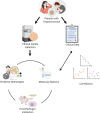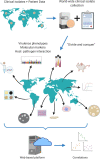Cryptococcal Virulence in Humans: Learning From Translational Studies With Clinical Isolates
- PMID: 33968804
- PMCID: PMC8097041
- DOI: 10.3389/fcimb.2021.657502
Cryptococcal Virulence in Humans: Learning From Translational Studies With Clinical Isolates
Abstract
Cryptococcosis, an invasive mycosis caused by Cryptococcus spp, kills between 20% and 70% of the patients who develop it. There are no vaccines for prevention, and treatment is based on a limited number of antifungals. Studying fungal virulence and how the host responds to infection could lead to new therapies, improving outcomes for patients. The biggest challenge, however, is that experimental cryptococcosis models do not completely recapitulate human disease, while human experiments are limited due to ethical reasons. To overcome this challenge, one of the approaches used by researchers and clinicians is to: 1) collect cryptococcal clinical isolates and associated patient data; 2) study the set of isolates in the laboratory (virulence and host-pathogen interaction variables, molecular markers); 3) correlate the laboratory and patient data to understand the roles fungal attributes play in the human disease. Here we review studies that have shed light on the cryptococcosis pathophysiology using these approaches, with a special focus on human disease. Isolates that more effectively evade macrophage responses, that secrete more laccase, melanize faster and have larger capsules in the cerebrospinal fluid are associated with poorer patient outcomes. Additionally, molecular studies have also shown that cryptococcal clades vary in virulence, with clinical impact. Limitations of those studies include the use of a small number of isolates or retrospectively collected clinical data. The fact that they resulted in very important information is a reflection of the impact this strategy has in understanding cryptococcosis and calls for international collaboration that could boost our knowledge.
Keywords: Cryptococcus gattii; Cryptococcus neoformans; cryptococcosis; meningitis; virulence.
Copyright © 2021 de Sousa, Frazão, Oliveira Júnior, Albuquerque and Nicola.
Conflict of interest statement
The authors declare that the research was conducted in the absence of any commercial or financial relationships that could be construed as a potential conflict of interest.
Figures


Similar articles
-
Molecular typing, in vitro susceptibility and virulence of Cryptococcus neoformans/Cryptococcus gattii species complex clinical isolates from south-eastern Brazil.Mycoses. 2020 Dec;63(12):1341-1351. doi: 10.1111/myc.13174. Epub 2020 Sep 30. Mycoses. 2020. PMID: 32869413
-
Faster Cryptococcus Melanization Increases Virulence in Experimental and Human Cryptococcosis.J Fungi (Basel). 2022 Apr 12;8(4):393. doi: 10.3390/jof8040393. J Fungi (Basel). 2022. PMID: 35448624 Free PMC article.
-
Vaccination with Recombinant Cryptococcus Proteins in Glucan Particles Protects Mice against Cryptococcosis in a Manner Dependent upon Mouse Strain and Cryptococcal Species.mBio. 2017 Nov 28;8(6):e01872-17. doi: 10.1128/mBio.01872-17. mBio. 2017. PMID: 29184017 Free PMC article.
-
[Cryptococcosis caused by Cryptococcus neoformans var. Gattii. A case associated with acquired immunodeficiency syndrome (AIDS) in Kinshasa, Zaire].Med Trop (Mars). 1992 Oct-Dec;52(4):435-8. Med Trop (Mars). 1992. PMID: 1494313 Review. French.
-
[Mechanism of Cryptococcus Meningoencephalitis].Med Mycol J. 2016;57(1):J27-32. doi: 10.3314/mmj.57.J27. Med Mycol J. 2016. PMID: 26936349 Review. Japanese.
Cited by
-
Bacterial-fungal interactions and their impact on microbial pathogenesis.Mol Ecol. 2023 May;32(10):2565-2581. doi: 10.1111/mec.16411. Epub 2022 Mar 14. Mol Ecol. 2023. PMID: 35231147 Free PMC article. Review.
-
Three Models of Vaccination Strategies Against Cryptococcosis in Immunocompromised Hosts Using Heat-Killed Cryptococcus neoformans Δsgl1.Front Immunol. 2022 May 9;13:868523. doi: 10.3389/fimmu.2022.868523. eCollection 2022. Front Immunol. 2022. PMID: 35615354 Free PMC article.
-
Importance of Clinical Isolates in Cryptococcus neoformans Research.J Fungi (Basel). 2023 Mar 16;9(3):364. doi: 10.3390/jof9030364. J Fungi (Basel). 2023. PMID: 36983532 Free PMC article. Review.
-
Clinical Manifestations of Human Exposure to Fungi.J Fungi (Basel). 2023 Mar 21;9(3):381. doi: 10.3390/jof9030381. J Fungi (Basel). 2023. PMID: 36983549 Free PMC article. Review.
-
Use of Clinical Isolates to Establish Criteria for a Mouse Model of Latent Cryptococcus neoformans Infection.Front Cell Infect Microbiol. 2022 Feb 2;11:804059. doi: 10.3389/fcimb.2021.804059. eCollection 2021. Front Cell Infect Microbiol. 2022. PMID: 35186781 Free PMC article.
References
-
- Beale M. A., Sabiiti W., Robertson E. J., Fuentes-Cabrejo K. M., O’Hanlon S. J., Jarvis J. N., et al. . (2015). Genotypic diversity is associated with clinical outcome and phenotype in cryptococcal meningitis across Southern Africa. PloS Neglect Trop. Dis 9 (6), e0003847. 10.1371/journal.pntd.0003847 - DOI - PMC - PubMed
Publication types
MeSH terms
LinkOut - more resources
Full Text Sources
Other Literature Sources
Miscellaneous

